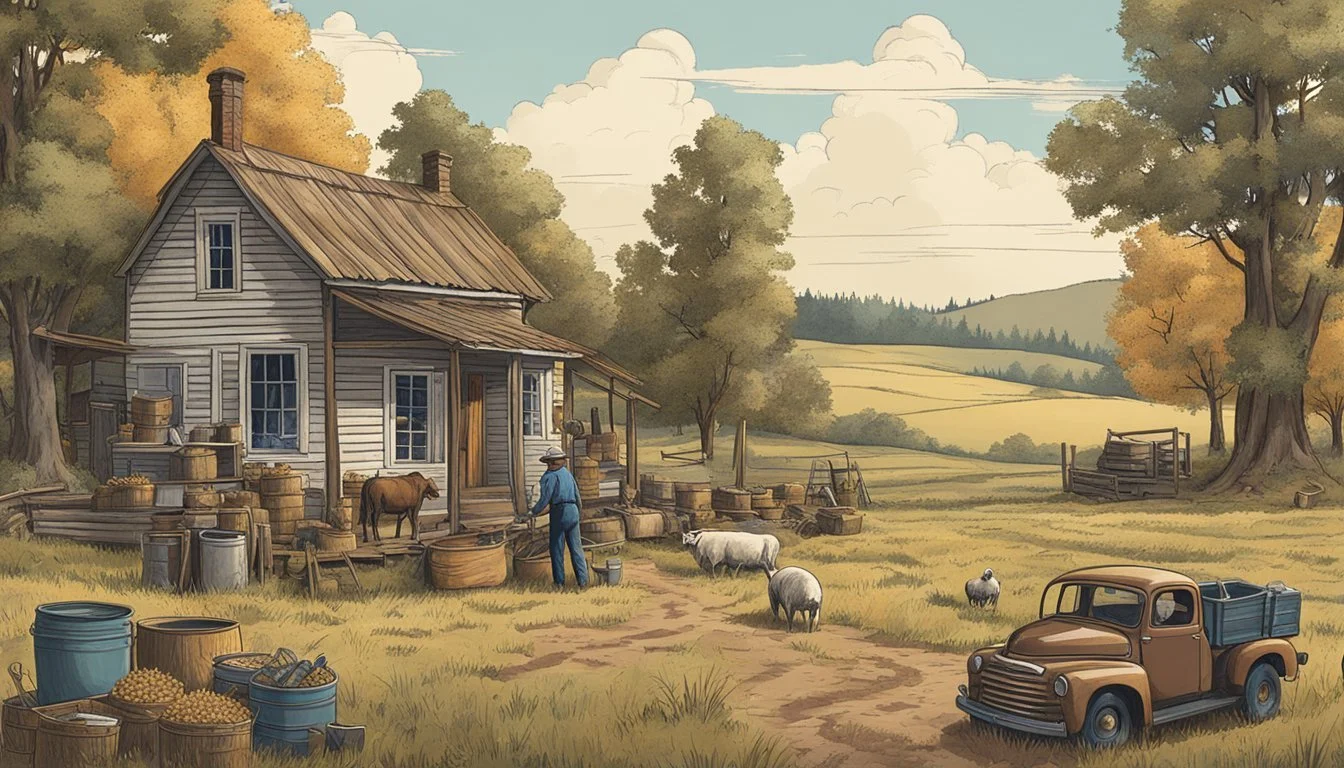Is Self-Reliance as a Homesteader a Myth?
Unveiling the Reality of Independent Living
The concept of self-reliance finds its roots deeply woven into the fabric of homesteading culture. Historically, homesteaders are portrayed as paragons of self-sufficiency, producing their food, building their own homes, and forging tools from raw materials. This image has been romanticized and serves as a beacon for those aspiring to a life of independence from societal systems. However, the practical application of self-sufficiency in modern homesteading warrants scrutiny.
In an increasingly interconnected world, the idea of complete independence for homesteaders may indeed be more myth than reality. Factors such as reliance on external resources for initial setup, occasional dependence on the market for tools, and the utilization of community support networks suggest that the absolute form of living self-reliantly often ascribed to homesteaders may not be entirely attainable.
The myth of homesteading self-sufficiency does not diminish the strides many make toward sustainable living and reduced dependency. Instead, it highlights a more nuanced understanding that self-reliance is a spectrum. Homesteaders often embrace many aspects while also engaging with the broader community and market as necessary. This balance between autonomy and external reliance illustrates that self-reliant living is not an all-or-nothing proposition but rather a goal.
Self-Reliant Ideals
Developing self-reliance in the context of homesteading requires the pursuit of independent living through the acquisition of skills and sustainability practices.
A great sense of accomplishment and pride can come with providing for one's self or family through one's means and ability.
Self-reliant ideals have a philosophical underpinning brought to us by Ralph Waldo Emerson, a great man, and modern adaptations that navigate between aspiration and practicality.
Historical Context and Philosophies
The ethos of self-reliance has its roots in the insight found in the writings of Ralph Waldo Emerson and Henry David Thoreau, philosophers and self-reliant Huguenots who broke away from the French ministry and championed the virtues of individual responsibility, independence, and self-sufficiency.
In his essay “Self-Reliance,” Emerson encourages the individual to trust oneself and reject conformity. Thoreau, in "Walden," illustrates a two-year experiment in simple living, a quintessential romantic vision of freedom from dependence on society.
These philosophy-based ideals born from Emerson's essay foster modern beliefs and breed confidence in those looking to break free and establish enterprising, independent lives for themselves, ones where they rely less and less on societal constructs, authority, and higher powers.
It is an existential transition for some modern homesteaders, at the heart is an emotional drive, relying on one's abilities allows them to create a purposeful existence.
Myths Versus Reality of Independent Living
While the freedom and romance of complete autonomy are compelling, the reality is that true self-reliance requires taking absolute responsibility and is fundamentally a myth for most.
True independence is mitigated by the interdependencies within society, including trade, communal support, and shared innovation. Although the ideal of self-reliant living guides homesteaders, it is balanced by a practical need for some level of community and external resources.
Challenges Faced to Develop Self-Reliance
The path to self-reliant living for homesteaders is fraught with varying obstacles. While the allure is strong, they must have the confidence to navigate a complex maze of regulatory, economic, and practical challenges.
Access to Resources and Knowledge
Homesteaders often find the need for diverse resources and extensive knowledge to be a significant hurdle. Resources, ranging from seeds to machinery, require money and reliable suppliers.
In parallel, profound knowledge in areas such as agriculture, animal husbandry, and construction is vital. Education is crucial for solving problems and generating ideas. Homesteaders typically rely on a combination of physical stores, online suppliers, and community exchanges to obtain necessary items.
Resources Needed: Seeds, building materials, livestock
Knowledge Sources: Books, online forums, workshops
Healthcare and Emergency Services
In the realm of health, access to medical care is a critical concern. Homesteaders living in remote locations may be hours away from the nearest hospital, complicating emergency responses. Additionally, the availability of routine healthcare services can affect long-term well-being.
Nearest Hospital: An average of 30 miles away
Routine Care: Local clinics, visiting professionals
Government Regulations and Laws
Navigating the intricacies of government regulations and laws is another reality that can impact the level of self-reliance achievable. Homesteaders must comply with zoning laws, building codes, and environmental regulations, which can dictate how they use their land and resources.
Zoning Laws: Agricultural, residential, mixed-use
Building Codes: Safety standards, construction permits
Economic and Time Restrictions
Economic constraints and time restrictions also play a pivotal role in the self-sufficiency equation. Financial investment is necessary for establishing and maintaining a homestead, and the time required to manage it can be substantial.
Initial Investment: Land, housing, infrastructure
Ongoing Costs: Maintenance, utilities, property taxes
The degree of self-sufficiency possible is directly influenced by how effectively they manage these variables.
Balancing Self-Reliance and Community Interdependence
Homesteaders must recognize the importance of interdependence with the surrounding community.
They balance individualism with communal participation, understanding that lasting self-sufficiency benefits from a synthesis of personal efforts and external support.
Sometimes a person striving to do it all for themselves is less able to decide when they need help or less willing to ask for it. Being confident in your skillsets is crucial, to knowing when to seek outside help.
Cooperation among friends, the community, and civil society at large can increase resilience, pass skills to children, and develop more confidence in oneself, providing a safety net during challenging times, physically and mentally.
The New York Citi Bike System bike share embodies interdependent living that is driven by the need to move away from state reliance.
Examples of Community Interdependence:
Collective action in public projects
Knowledge sharing through workshops
Mutual aid in times of scarcity or abundance
Urban community gardens
Car-share, bike-share
The Impacts of Self-Reliant Living
Understanding environmental and societal impacts is crucial for evaluating the viability of homesteading as a sustainable practice in a world that is constantly changing.
Homesteading and Sustainability
The aspiration to adopt homesteading practices often stems from environmental concerns and the pursuit of sustainability.
Homesteaders tend to use resources efficiently, incorporating renewable energy and reducing waste whenever possible. Being more aware gives resources more meaning, helping to establish purposeful living.
By limiting their reliance on industrial food systems, they often decrease their carbon footprint and participate actively in preserving the environment.
Resource Management: Conscientious use of water, soil, and energy.
Waste Reduction: Composting and recycling to minimize landfill contributions.
Local Food Production: This reduces transportation emissions and packaging waste.
The Role of the Environment
The environment plays a crucial role in homesteading and directly influences the extent to which homesteaders can achieve a balance.
Climate: Determines what food can be grown and when.
Soil Health: Directly impacts the nutritional value and yield of crops.
Biodiversity: Maintaining a diverse ecosystem encourages natural pest control and healthy crops.
A homestead’s operations are meant to coexist with the local ecosystem, rather than overpower it, making the balance between the environment and human activity essential for sustainability.
Cultural Perception and Media
The cultural perception of homesteaders and the allure of off-grid living are heavily influenced by media representations. These representations can often shape public opinion and inform the collective understanding of what it means to be a homesteader.
Media Portrayal of Homesteaders
Television shows like Homestead Rescue and Live Free or Die have brought homesteading into the public eye, showcasing the challenges and successes of living off the land.
These programs tend to highlight the resilience and resourcefulness required to be self-sufficient. However, they can also contribute to a romanticized view of homesteading that may not fully capture the difficulties involved.
Homestead Rescue: Depicts families being assisted by experts to rectify their failing homesteads, often emphasizing the hard work and ingenuity needed.
Live Free or Die: Focuses on individuals who choose to live off the grid, away from modern conveniences, highlighting the philosophy behind their lifestyle choices.
Shows like Doomsday Preppers and the term survivalists are part of the media lexicon associated with extreme self-reliance, some of these shows dramatize things so heavily that these preppers are not treated respectfully.
Doomsday Preppers: Features individuals preparing for various catastrophes, often emphasizing extreme self-reliance and preparedness.
Survivalists: They are individuals or groups focused on survival in case of societal collapse, and they are often portrayed as highly skilled and prepared for any scenario.
The Role of External Support and Modern Conveniences
Despite a strong emphasis on self-sufficiency, no homesteader exists in a vacuum. External support systems such as access to modern medical treatment and security services underpin the lifestyle
For instance, should a severe injury occur, the availability of a nearby hospital or medical clinic ensures rapid care, going beyond the limitations of home-based first aid.
Likewise, relying on services such as fire departments and law enforcement provides security in the event of a disaster.
Conclusion
On careful examination of the ethos of Emerson and the truth, one finds that the concept of self-reliance boils down to setting self-reliant ideals built around your own values rather than a practical reality.
Most homesteaders are integrated into, not detached from, broader societal systems. Dependence on external goods and services such as medical care, is common.
Homesteaders may cultivate substantial degrees of self-sufficiency, producing food, building shelters, and creating energy solutions on their land. However, the purist notion of self-reliance that excludes any external support is rare, if not unattainable.
While they are taking personal responsibility and often produce much of what they need, external factors like climate, market forces, and legal frameworks influence their way of living.
It reinforces that self-reliance is more accurately described as a continuum, with most homesteaders situated at various points along the scale, rather than embodying a self-made all-or-nothing trait.
In essence, while self-reliance is a foundational aim of homesteading, the degree to which it is achieved varies greatly but can bring great happiness as they create a purposeful life.
The resilient spirit of a homesteader often involves a balanced interplay between self-produced resources and selective engagement with wider economic and societal infrastructures.





